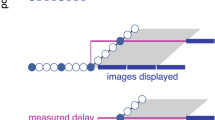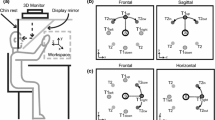Summary
1. The control of pointing arm movements in the absence of visual guidance was investigated in unpracticed human subjects. The right arm grasped a lever which restricted the movement of the right index fingertip to a horizontal arc, centered between the axes of eye rotation. A horizontal panel directly above the arm prevented visual feedback of the movement. Visual stimuli were presented in discrete positions just above panel and fingertip. A flag provided visual feedback on fingertip position before each pointing movement (Exp. A and B), or before a movement sequence (Exp. C). 2. When subjects pointed from straight ahead to eccentric stimulus positions (Exp. A), systematic and variable pointing errors were observed; both kinds of errors increased with stimulus eccentricity. When subjects pointed from 30 deg left to stimuli located further right (Exp. B), errors increased with stimulus position to the right. Taken together, these findings suggest that pointing accuracy depends not primarily on stimulus position, but rather on required movement amplitude. 3. When subjects performed sequences of unidirectional movements (Exp. C), systematic and variable errors increased within the sequence. A quantitative analysis revealed that this increase can be best described as an accumulation of successive pointing errors. 4. We conclude that both findings, error increase with amplitude, and accumulation of successive errors, when considered together strongly support the hypothesis that amplitude, rather than final position, is the controlled variable of the investigated movements.
Similar content being viewed by others
References
Abend W, Bizzi E, Morasso P (1982) Human arm trajectory formation. Brain 105: 331–348
Benati M, Gaglio S, Morasso P, Tagliasco V, Zaccaria R (1980) Antropomorphic robotics. I. Representing mechanical complexity. Biol Cybern 38: 125–140
Bernstein N (1935) The problem of the interrelation of coordination and localisation. Arch Biol Sci 38: 15–59. Reprinted in: Bernstein N (1967) The coordination and regulation of movements. Pergamon Press, Oxford
Biguer B, Prablanc C, Jeannerod M (1984) The contribution of coordinated eye and head movements in hand pointing accuracy. Exp Brain Res 55: 462–469
Bizzi E, Accornero N, Chapple W, Hogan N (1984) Posture control and trajectory formation during arm movement. J Neurosci 4: 2738–2744
Day BL, Marsden CD (1982) Accurate repositioning of the human thumb against unpredictable dynamic loads is dependent upon peripheral feedback. J Physiol 327: 393–407
Fel'dman AG (1974) Change in the length of the muscle as a consequence of a shift in equilibrium in the muscle-load system. Biofizika 19: 535–538
Fitts PM (1954) The information capacity of the human motor system in controlling the amplitude of movement. J Exp Psychol 47: 381–391
Ghez C, Vicario D (1978) The control of rapid limb movement in the cat. II. Scaling of isometric force adjustments. Exp Brain Res 33: 191–202
Gielen CCAM, van den Heuvel PJM, van Gisbergen JAM (1984) Coordination of fast eye and arm movements in a tracking task. Exp Brain Res 56: 154–161
Held R, Bauer J (1974) Development of sensorially-guided reaching in infant monkeys. Brain Res 71: 265–271
Hollerbach JM, Flash T (1982) Dynamic interactions between limb segments during planar arm movement. Biol Cybern 44: 67–77
Kelso JAS (1977) Motor control mechanisms underlying human movement reproduction. J Exp Psychol Hum Percept Perform 3: 529–543
Kelso JAS, Holt KG (1980) Exploring a vibratory systems analysis of human movement production. J Neurophysiol 43: 1183–1196
Laabs GJ (1973) Retention characteristics of different reproduction cues in motor short-term memory. J Exp Psychol 100: 168–177
Lacquaniti F, Soechting JF, Terzuolo CA (1982) Some factors pertinent to the organisation and control of arm movements. Brain Res 252: 394–397
Lashley KS (1917) The accuracy of movement in in the absence of excitation from the moving organ. Am J Physiol 43: 169–194
Lashley KS (1951) The problem of serial order in behavior. In: Jeffress LA (ed) Cerebral mechanisms in behaviour. Hafner, New York, pp 112–136
Morasso P (1981) Spatial control of arm movements. Exp Brain Res 42: 223–227
Polit A, Bizzi E (1979) Characteristics of motor programs underlying arm movements in monkeys. J Neurophysiol 42: 183–194
Prablanc C, Echallier JF, Komilis E, Jeannerod M (1979a) Optimal response of eye and hand motor systems in pointing at a visual target. I. Spatio-temporal characteristics of eye and hand movements and their relationships when varying the amount of visual information. Biol Cybern 35: 113–124
Prablanc C, Echallier JE, Jeannerod M, Komilis E (1979b) Optimal response of eye and hand motor systems in pointing at a visual target. II. Static and dynamic visual cues in the control of hand movement. Biol Cybern 35: 183–187
Sanes JN, Evarts EV (1983) Effects of perturbations on accuracy of arm movements. J Neurosci 3: 977–986
Schmidt RA, Zelaznik HN, Hawkins B, Frank JS, Quinn Jr JT (1979) Motor output variability: a theory for the accuracy of rapid motor acts. Psychol Rev 86: 415–451
Taub E, Goldberg LA, Taub P (1975) Deafferentation in monkeys: pointing at a target without visual feedback. Exp Neurol 46: 178–186
Viviani P, Terzuolo CA (1980) Space-time invariance in learned motor skills. In: Stelmach GS, Requin J (eds) Tutorial in motor behaviour. North Holland, Amsterdam, pp 525–533
Woodwoth RS (1899) The accuracy of voluntary movement. Psychol Rev Monogr Suppl 3
Author information
Authors and Affiliations
Rights and permissions
About this article
Cite this article
Bock, O., Eckmiller, R. Goal-directed arm movements in absence of visual guidance: evidence for amplitude rather than position control. Exp Brain Res 62, 451–458 (1986). https://doi.org/10.1007/BF00236023
Received:
Accepted:
Issue Date:
DOI: https://doi.org/10.1007/BF00236023




